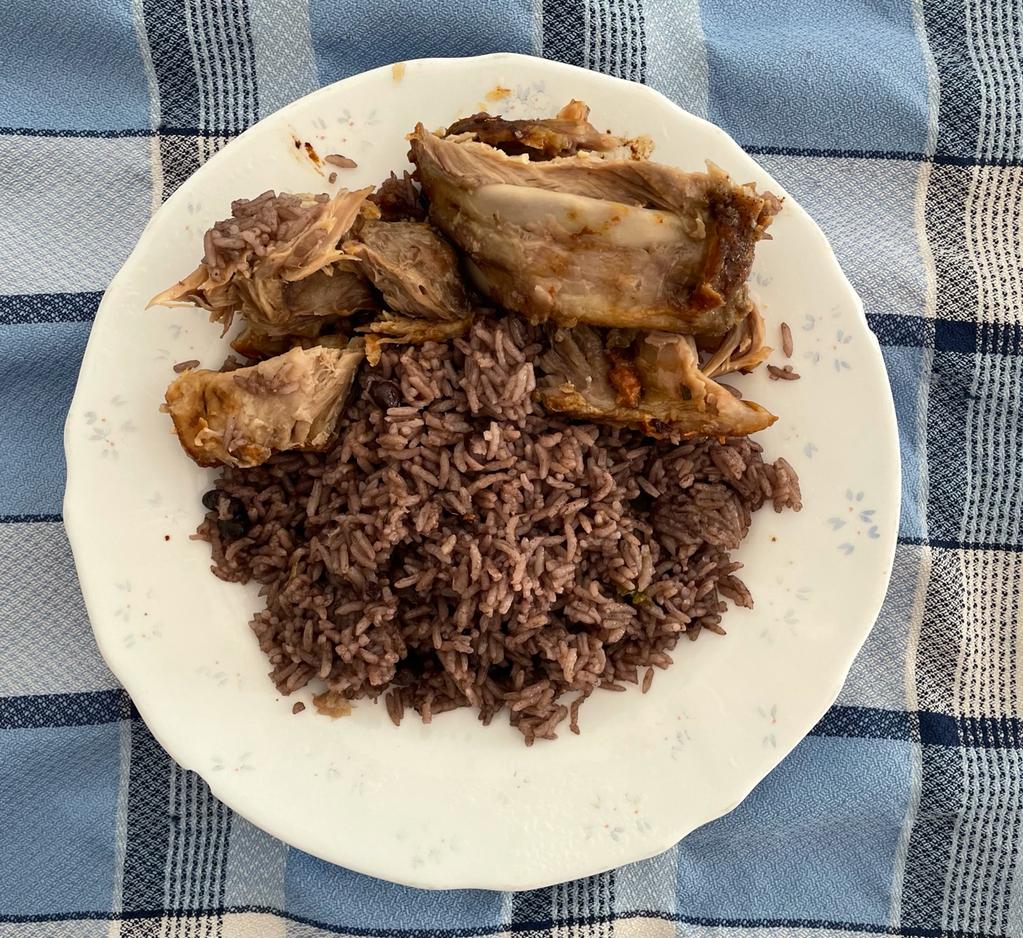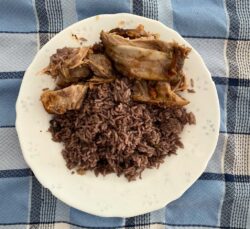Winter 2007
Caribbean Connections
Foodwise, Louisiana and its island neighbors are south of the South
Published: June 16, 2022
Last Updated: June 16, 2022

Wikimedia Commons user ERomeroA
Cuban congri with chicken.
Historically and culturally, South Louisiana has much more in common with the island nations to its south. The region could arguably be called the northernmost point in the Caribbean. With the Caribbean basin it shares a Roman Catholic tradition, a three-class structure of society of black, white, and brown (as opposed to the South’s black and white), a range of Gallic and Hispanic cultural influences, a tradition of cane-growing, a history punctuated by devastating hurricanes, and a shared love of the exuberance of Carnival. Nowhere, though, are the connections more startling than in the cooking pots of both areas.
I remember the flowers had not yet withered on Papa Doc’s grave the first time that I set foot in Haiti, and Castro was speaking in the Plaza de la Revolución in Havana when I first went to Cuba. For me, the connections between the foods of the Caribbean and South Louisiana are one of the most binding ties that they share.
Consider that both regions revel in matters culinary, with a gastronomic delight that owes more to France than to the colder European climes. So too, Spain’s culinary Mediterranean brightness appears on the plate in the form of tomatoes, garlic, bell peppers and more. In South Louisiana, and in Haiti and Cuba, African hands have marked the pots, adding soupy stews and gumbos, a love for foods fried in deep oil, a taste for hot sauces, the use of off cuts of pig, and a history of confections that make use of sugar cane, molasses, and nuts such as pecans and peanuts. In this column, though, I want to talk not about the gumbo train or the praline connection but of the rice dishes that are a part of our common heritage.
In Africans in Colonial Louisiana: The Development of Afro-Creole Culture in the Eighteenth Century, historian Gwendolyn Midlo Hall informs us that the first two slave ships arrived in Louisiana in 1719 from Africa, bringing not only enslaved Africans but also seed rice in an effort to introduce rice cultivation to the colony. By 1720, rice was growing along the Mississippi. The grain became so abundant that it was occasionally exported to the French Caribbean and to Spanish Pensacola. Midlo Hall and Judith Carney, geographer and author of Black Rice: The African Origins of Rice Cultivation in the Americas, suggest that the rice in the case of both Louisiana and Haiti may have been Oryza glaberrima, a rice that is native to the rice-growing regions of West Africa. While it has long been acknowledged that Spain received its rice cuisine, and indeed the grain itself, from its North African conquerors the Moors, many forget that the Moors were from an area that had been on a trade route and in close contact with rice-growing regions on the West African coast for centuries. Still more are unaware that West Africa can boast its own variant of rice.
Looking at the historic cookbooks of that other American rice-growing region, Charleston and the South Carolina Low Country, one is struck by the numbers of rice breads, pilaus (or purloos to use the Charleston term), croquettes, cookies, and casseroles, but there are few of these in the first New Orleans cookbooks. In some cases those that do appear often acknowledge their link to the Spanish and French Caribbean in name or ingredients.
Perhaps rice was so commonplace that recipes were not deemed necessary. Of the few that remain—red beans and rice, jambalaya, and congri—the connections are flagrant. My “ah-ha” moment came several decades back. In the 1970s, the road from Port au Prince, Haiti, north to Cap Haitien was bumpy and rutted, but it was a culinary highway offering numerous surprises: peasants by the roadside sold mangos and citrus from woven baskets; cafes looked like sepia versions of those I’d seen in France; and around one memorable turn, a vista of rice paddies appeared that seemed transported from Southeast Asia. I’d never thought of rice growing in the Caribbean or the connections with the rice-growing regions of the United States. One day, years later, while thumbing through my Haitian cookbooks, I was surprised and delighted to find a recipe for a dish simply called riz national or pois ac diri (rice and peas in Kreol). All of the recipes call for rice, red beans or kidney beans, seasonings, and some form of smoked pork, bacon, ham, sausage, or salt pork. Make the beans Camellia and cook them on Monday, and voilà! red beans and rice, New Orleans style! The dish that is Monday’s hallmark in the Crescent City is so popular in Haiti that it is simply known as national rice.
Jambalaya, the dish that appears in the The Picayune’s Creole Cookbook (1901), is always acknowledged as a “Spanish Creole” dish. It also appears in the Creole Cookery Book of the Christian Women’s Exchange as jumballaya. While both have the notation that it is a Spanish Creole dish, many forget that the Spanish in question were undoubtedly from the Spanish Caribbean, not the Iberian Peninsula. The Picayune’s Creole Cookbook’s Creole jambalaya is not far from one variation from Santiago de Cuba, a city in the country’s eastern section. This congri is a composed rice dish of pork, bacon, sausages, red beans, onion, carrots, shallots, tomatoes, celery, chiles, tomato puree, oil, seasonings, and rice with more than a tot of rum! Without the rum, the dish could pass for a variant of jambalaya.
The Picayune’s Creole Cookbook offers three versions of jambalaya: a classic one, billed as Creole jambalaya, another with shrimp, and a third called jambalaya au congri. In Cuba, the classic congri is simply a mix of rice and beans with the possible addition of red bell pepper. One recipe for this dish comes with the notation that congri is red beans and rice prepared with kidney beans, salt pork, onion, bell peppers, garlic, seasonings, rice, and water. Cuba, while best known to many for its black beans, in fact has a line of bean demarcation. People in both Jamaica and Oriente, the eastern end of the Cuba closest to Haiti, eat red beans or pink beans. Black beans, which are eaten on the western side of Cuba, are a part of the congri of that section of the country. There, black bean congri is eaten along with the more familiar moros y cristianos (“Moors and Christians” or black beans and white rice). In Monday’s red beans and rice, South Louisiana follows the bean preference of both its Haitian and its eastern Cuban “cousins.” Louisiana’s congri is a different matter. In the third of the jambalaya recipes in The Picayune’s Creole Cookbook, jambalaya au congri, the two culinary terms come together in a dish of cowpeas, ham, onion, salt meat, and seasonings that would be familiar to most Southerners as hoppin’ john, the classic South Carolina purloo.
Leah Chase, doyenne of Creole cooking, informed me that congri was still common in her youth, and it was and will be on the menu at Dooky Chase restaurant in New Orleans. She recalled that Louisiana congri was a spring dish in her family, one that was prepared not with black-eyed peas, but when the field peas or crowder peas were fresh. It was peas and rice with field peas and often accompanied with panéed veal. I’m sure that as her family sat around the table they had no idea that they were links in a culinary chain of rice dishes that went beyond their southern Louisiana community, south into the Caribbean and north to link with other creolized cuisines and the world.
Jessica B. Harris, PhD, is the author of eight books documenting the foods and foodways of the African Diaspora.
